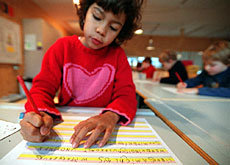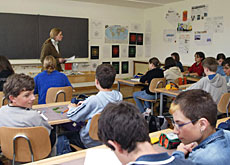Swiss education system lags behind

Switzerland still lags behind other countries when it comes to offering equal education to men and women.
The latest report by the Organisation for Economic Cooperation and Development (OECD) has found that Swiss men enjoy a better school education than women.
According to the OECD’s “Education Study At A Glance” 2003 report, twice as many men as women remain in school for longer than the compulsory nine years.
It also found that the discrepancy between male and female students is nowhere as big as in Switzerland, where 20 per cent more men have a university degree than women.
Anna Borkowsky of the Federal Statistics Office says the OECD’s figure is relative and it depends on the kinds of university degrees that are compared.
“If you look at Switzerland’s traditional universities, the numbers of male and female students are pretty even. However, when it comes to technical colleges the number of male students is much higher,” Borkowsky told swissinfo.
“But when you look at typical female professions such as medicine, for example, the numbers are more equal.”
Further education
However, when it came to further education Switzerland fared relatively well, with almost 90 per cent of all men and women between the ages of 25 and 34 finishing some sort of training.
“It’s due to our system of apprenticeships that we have so far fared quite well in international comparison,” Borkowsky said.
The Swiss education system used to be considered one of the best in the world. However, the latest study shows that Denmark, Japan, Poland, Germany and Finland have overtaken Switzerland and offer a better education system.
The study also found that an average of 41 per cent of the population in OECD countries finish a college or a university degree. In Switzerland only one third of young people graduate from college.
However, compared with Italy, where only 0.3 per cent of young people graduate from college, Switzerland fares quite well.
With 27 per cent, Japan has the highest number of university graduates.
Pisa study
Two years ago the OECD shocked the Swiss educational establishment when it published a report that found that up to 20 per cent of 15 year olds could not understand even the most basic written information.
The findings of the Programme for International Student Assessment (Pisa) revealed big gaps in educational standards between Swiss students from higher and lower social backgrounds, and between pupils who spoke a Swiss national language as their mother tongue, and those who did not.
Following the report’s publication, the Swiss realised that they could no longer rest on their laurels as pioneers of educational reform and developed a new education action plan, which was unveiled in June this year.
The “Education At A Glance” report focuses on the quality of students’ achievements and on the policies that help to shape these achievements.
swissinfo with agencies
The OECD publishes its “Education At A Glance“ report annually.
The discrepancy between the number of male and female students is nowhere as big as in Switzerland.
90% of all Swiss have some sort of further education.
20% more men than women have a university degree.

In compliance with the JTI standards
More: SWI swissinfo.ch certified by the Journalism Trust Initiative










You can find an overview of ongoing debates with our journalists here . Please join us!
If you want to start a conversation about a topic raised in this article or want to report factual errors, email us at english@swissinfo.ch.